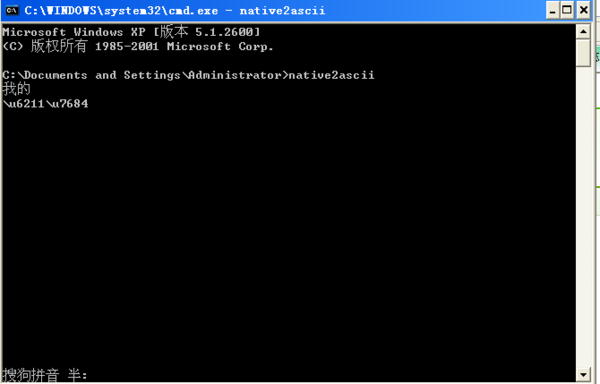怎么用native2ascii处理properties文件
- 时间:2015年04月02日 15:16:59 来源:魔法猪系统重装大师官网 人气:15932
Liferay的资源文件做的还是不错的,基本上界面里的所有消息都放到了资源文件中。具体中文的就是:portal-impl/content下面的Language_zh_CN.properties和Language_zh_CN.properties.native。前一个是unicode字符串,后一个是中文。先将哪个native文件内容翻译过来,再把汉字转化为unicode替换前一个文件就OK了。
可native文件中居然有3000多条,如果全手工通过native2asccii来转换的话,简直是恶梦。因为我是懒人嘛,当然要用懒办法。写了个Java程序调用native2ascii搞定。
native2ascii这个工具主要用来把本地编码(比如gbk)的文件转换成标准的Properties属性文件。
属性文件中,除字母数字外的字符要用\转义,具体的标准参考java文档Properties类的说明。
那这个转换的原理是什么呢?自己如何实现呢?
只能概括下原理。
替换掉本地编码的文本文件中所有的非ascii字符:
比如汉字,先从本地编码GBK转换成对应的unicode字符,
再把这个字符的字符码,以\u21342的形式写回。
char a='你';
System.out.println(a+" -> \\u"+(int)a);
===========
你 -> \u20320
(int)a 出来的结果不太对嘛!
你应该对应\u4f60
只是我忽略了进制,要求是16进制,我给的是10进制。
"原理"是对的
你的基础差到连一点变通都没法吗?
char a='你';
System.out.println(a+" -> \\u"+Integer.toHexString((int)a));
===========
你 -> \u4f60
首先要安装JDK(不是jre),安装好后将jdk的bin目录添加到系统变量path中,然后就可以使用native2ascii命令在控制台(cmd)中进行转码了
native2ascii a.properties b.properties
当前目录下要有a.properties这个文件,如果没有就要写全路径
如果你用eclipse做开发工具,还是下载一个propedit的插件吧
直接打开运行,输入cmd,就可以转码了,如图

代码如下:
import java.io.FileInputStream;
import java.io.FileWriter;
import java.io.IOException;
import java.io.InputStreamReader;
import java.io.OutputStream;
import java.io.UnsupportedEncodingException;
import java.util.Iterator;
import java.util.Properties;
/**
* @author smilingleo E-mail:liuwei.dt@gmail.com
* @version created time:2007-11-2 上午11:37:55 类说明:
*/
public class Native2Ascii {
static String java_bin_path = "C:/Java/jdk1.5/bin";
public Native2Ascii() {
}
public Properties getProperties(String filename) throws IOException {
Properties p = new Properties();
ClassLoader cl = this.getClass().getClassLoader();
FileInputStream input;
input = new FileInputStream(filename);
p.load(input);
return p;
}
public String getUnicodeString(String value) {
StringBuffer tempSb = new StringBuffer();
try {
Process pro = Runtime.getRuntime().exec(
java_bin_path + "/native2ascii.exe ");
OutputStream out = pro.getOutputStream();
out.write(value.getBytes());
out.flush();
out.close();
InputStreamReader child_in = new InputStreamReader(pro.getInputStream());
int c;
while ((c = child_in.read()) != -1) {
tempSb.append((char) c);
}
} catch (UnsupportedEncodingException e) {
e.printStackTrace();
} catch (IOException ex) {
ex.printStackTrace();
}
return tempSb.toString();
}
/**
* @param args
*/
public static void main(String[] args) {
String sourceFile = "Language_zh_CN.properties";
String targetFile = "target.properties";
if (args.length != 2) {
System.out.println("Usage: java Native2Ascii
" Author:Smilingleo" +
" Blog:blog.csdn.net/smilingleo");
// System.exit(0);
}else{
sourceFile = args[0];
targetFile = args[1];
}
Native2Ascii parser = new Native2Ascii();
StringBuffer sb = new StringBuffer();
try {
//Convert the source file into unicode first.
Properties p = parser.getProperties(sourceFile);
Iterator iterator = p.keySet().iterator();
while (iterator.hasNext()){
Object key = iterator.next();
String value = p.get(key).toString();
value= new String(value.getBytes("ISO-8859-1"),"UTF-8");
value = parser.getUnicodeString(value);
// System.out.println(key + ":" + value);
p.setProperty(key.toString(), value);
sb.append(key.toString() + "=" + value);
}
//write the target file.
FileWriter out = new FileWriter(targetFile);
out.write(sb.toString());
out.flush();
out.close();
} catch (Exception e) {
e.printStackTrace();
}
}
}
////////////////////////
后来发现其实上面的做法是脱了裤子放屁,native2ascii本身就能完美的完成这个工作。其详细用法如下:
native2ascii [options] [inputfile [outputfile]
在options中指定-encoding UTF8就OK了。
呵呵,不过上面程序也不能说完全没有用,权当作为一个用java调用操作系统进程的一个练习吧。









